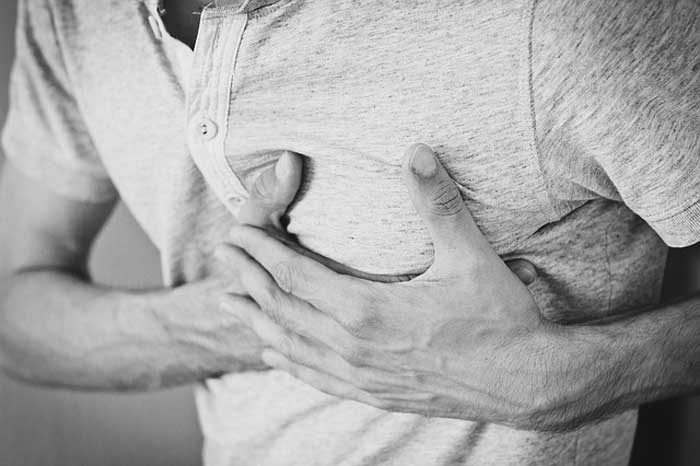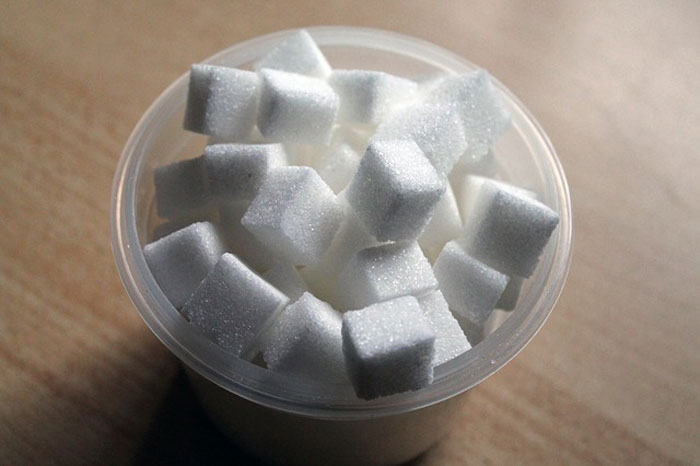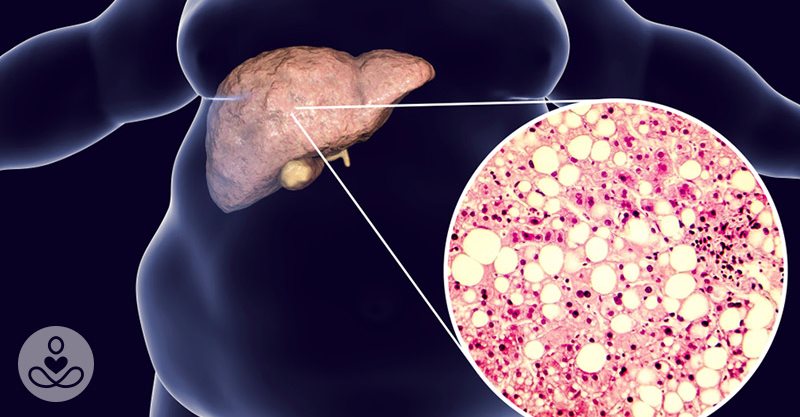This article was originally published on October 20, 2020, and has since been updated.
You’ve heard it’s bad for you and yet many Americans still consume way too much sugar. Honestly, it’s pretty easy to underestimate how much sugar you consume, especially if you aren’t paying close attention; it is in sauces, dressings, baked goods, fruit, and even “healthy” packaged foods. Usually, people automatically think of type 2 diabetes and obesity when it comes to sugar consumption. However, recent studies are emphasizing the drug-like food’s impact on the liver and fatty liver disease.
And don’t think just because you’ve gone gluten-free, it’s healthier; many gluten-free products have more sugar than their gluten counterparts. To compound matters, the Food and Drug Administration allows manufacturers to use up to 61 different names for sugar, so it isn’t always easy to spot! [1]
Sugar, in quantities consumed regularly in America, is a huge health problem. Americans consume on average, 3-6X more added sugar than the maximum daily amount recommended! The average sugar intake is around 22 teaspoons, with teenagers consuming the most, at 34 teaspoons a day! [2]
After reading that, it should come as no surprise that sugar consumption is linked (and can causes) many of the most damaging chronic conditions including fatty liver disease, heart disease (e.g., dyslipidemia), cancer, insulin resistance leading to pre-diabetes and Type 2 Diabetes, a weakened immune system, digestive issues, tooth decay, and more. Excess sugar intake even leads to excess calories consumed, which can cause excess weight and obesity. [3-5]
Dosage Recommendations
The American Heart Association has recommended:
- Women limit their daily intake of sugar to 6 teaspoons and men to 9 teaspoons
- Children get no more than 3-6 teaspoons a day
One teaspoon contains about 4 grams of sugar, which equates to 24gms for women and 36gms for men, daily. This is especially important for heart health, but really also important for protecting the health of the whole body too! [2]
Liver Disease, Diabetes, Obesity, Heart Disease, and Brain Health

Table sugar (sucrose) and fruit both contain a mixture of fructose and glucose. In fruit, however, the sugars are generally not a problem, as they exist in a matrix with fiber, vitamins, and minerals, allowing them to be slowly absorbed in the body.
However, modern food manufacturers have come to extract and concentrate fructose from corn, beets, and sugarcane, removing fiber and nutrients in the process.
To truly be healthy and prevent chronic disease, you need to be really clear about how much fructose you consume. Why? Because glucose and fructose actually act way different in your body. From the way they are absorbed in the digestive system to the way, they affect different organs.
Liver Disease
Your liver in the meantime may likely be developing a condition known as non-alcoholic fatty liver disease. We used to think you could only have liver problems if you were an alcoholic or had a chronic liver condition like hepatitis.
We now know that fat stored in the liver, likely by excess fructose and excess poor quality dietary fats, leads to fatty liver. As many as 1 in 3 adults (roughly 31%) have the non-alcoholic fatty liver disease. [7]
Groundbreaking Study: Low Carb Is an Effective Treatment for Fatty Liver
In March 2018, scientists published a study in Cell Metabolism which helps shed light on what happens when you remove or decrease the amount of sugar and starch in your diet. The modest 10-person study was small, however, the findings could hold an answer to treating fatty liver disease completely naturally.
For the duration of the study, researchers fed participants a low-sugar, low-carbohydrate diet (with increased protein content in obese subjects). Incredibly, within the first day, participants started exhibiting lower levels of liver fat. Many of them even improved their cholesterol levels. [9]
As highlighted by Ann Fernholm, author, science journalist, and Ph.D. in molecular biotechnology: [10]
“The microbiome also changed. A surprising discovery was that it started producing more folic acid, a vitamin which is important in the liver’s metabolism. Low levels of folic acid has earlier been associated with an increased risk of fatty liver.”
Read: 14 Signs Your Blood Sugar Is Way Too High
Diabetes
After being absorbed, fructose doesn’t break down until it reaches your liver. It also doesn’t cause your pancreas to release insulin. Glucose, on the other hand, starts its breakdown in the stomach, long before it is even absorbed, and it is then transported into the bloodstream after absorption through the small intestine.
Once in the blood, glucose stimulates the release of insulin by the pancreas.
On the surface, this may look good and at one point fructose was even recommended to diabetics because of its ability to go undetected by the body (not stimulate insulin).
But, here is the not so good news: fructose is not kept in check, as it is absorbed into the small intestinal cells, whereas glucose must be actively transported into the body through a “gate.”
Obesity
Fructose will thus be continually absorbed if there is more of it in the digestive tract, say when you drink soda, juice, or eat a lot of sugar at once, in ice cream or fruit yogurt. Once the small intestinal cells have more fructose inside them, the body stops absorbing it.
But the moment that fructose gets moved to the bloodstream and transported to the liver, the intestinal cells will absorb more fructose that’s hanging out in the digestive tract. [6]
When you consume fructose and don’t burn it as fuel immediately, the liver ends up converting it into triglycerides to “save for later.” These are essentially fat globs.
They are stored in the liver and exported into the bloodstream to make their way to other organs. Triglycerides carry sugar to your fat cells to be stored.
Heart Disease
Triglycerides are also problematic in the arteries, as they end up causing plaque formation and can lead to cholesterol issues, blood pressure issues, and stroke risk (from thick turbulent blood).
Fructose is considered empty calories, especially when it is consumed in liquid form such as sodas, juices, etc. These empty calories will go right into the total calorie count, but you won’t feel fuller after consuming these foods.
The Brain
Curious what fructose does to the brain? A group of researchers looked at the blood flow changes on a functional MRI after ingestion of glucose versus fructose.
What they saw was fascinating: glucose reduced blood flow to the areas of the brain that control appetite and reward, whereas fructose allowed blood flow to continue to stimulate appetite and reward centers.
This means that after you eat glucose, you will become adequately more and more full, whereas with fructose, your appetite won’t change and you may eat twice as many calories (or at the very least more than you intended). Interestingly, fructose shut down blood flow activity to the memory and sensory perception regions. [8]
How to Cut Back on Sugar Intake

Read Labels
- Remember that sugar can be disguised under 61 pseudo-names, so be diligent learn what words are sometimes used to denote the sugar.
- Read the nutrition facts panel and see what count of carbohydrates and sugar it has.
- In general if more than half of the carbohydrates are sugar, put it back! There are of course a few exceptions such as yogurt and fruit. Because these are whole foods and contain many other nutritious compounds, count these toward your total daily sugar consumption, but it is ok if more than half of the carbohydrates of these are sugar, they will provide your body with a slow burn of sugar because of the protein and fiber, respectively.
Forget soda, sweetened beverages (lemonade, tea, etc.), and juice. There are 11 teaspoons of sugar in 1, 12-oz can of soda. Water first, always!
Sauces, dressings, marinades, jelly: read labels. Go for products with the fewest ingredients, or switch to simpler versions, such as olive oil and balsamic vinegar as a dressing for your salad. Instead of jelly, have whole fruit. Berries are particularly healthy and often low in sugar.
Yogurt with fruit, this one is super deceiving. If you flip the label around, you will see that sugar is also added in addition to the fruit!
- Most servings of fruit yogurt have 3-6 teaspoons of sugar. People are eating this for breakfast, which is similar to ice cream in sugar content.
- Instead, eat plain whole milk yogurt with your own fruit added.
Watch out for low-fat or fat-free products. Other than them being erroneously healthier without fat (we will save that for another discussion), they are often loaded up with way more sugar to make up for little to no fat. The problem is, this sugar often turns to fat in your body because if you consume too much sugar, you end up storing it as fat, as you learned above.
A Word on Whole Fruit
- A whole fruit has fiber to balance out the sugar. For example, an apple has 16-18gm of sugar and 1/5 of your dietary fiber. Because the fiber is broken down much more slowly than sugar, the sugar in the apple is only released a little bit at a time.
- Thus the sugar that goes into our bloodstream is lower and sustained over time. You actually get a steadier intake of sugar, which your body prefers.
So there you have it. You deserve to understand what things you put in your mouth may destroy your health. So pay attention to labels and focus on whole food forms of sugar, such as fruit, yogurt, and whole sweeteners.
Keep Reading: How Might Ginger Help with Obesity and Fatty Liver Disease?
Sources
- US Food and Drug Administration. How to Understand and Use the Nutrition Facts Label. https://www.fda.gov/food/ingredientspackaginglabeling/labelingnutrition/ucm274593.htm Published November 2004. Accessed November 30, 2016
- Johnson RK, et al. Dietary Sugars Intake and Cardiovascular Health A Scientific Statement From the American Heart Association. Circulation. 2009; 120:1011-1020. https://circ.ahajournals.org/content/circulationaha/120/11/1011.full.pdf Published September 2006. Accessed November 28, 2016
- Stanhope KL. Sugar consumption, metabolic disease, and obesity: The state of the controversy. Crit Rev Clin Lab Sci. 2016;53(1):52-67 https://www.ncbi.nlm.nih.gov/pubmed/26376619 Published September 2015. Accessed November 29, 2016.
- Basu S. The relationship of sugar to population-level diabetes prevalence: an econometric analysis of repeated cross-sectional data. PLoS One. 2013;8(2):e57873. https://www.ncbi.nlm.nih.gov/pubmed/23460912 Published February 2013. Accessed November 20, 2016.
- Slattery ML, et al. Dietary sugar and colon cancer. Cancer Epidemiol Biomarkers Prev. 1997 Sep;6(9):677-85. https://www.ncbi.nlm.nih.gov/pubmed/9298574 Published September 1997. Accessed November 25, 16
- Gaby A. Adverse Effects of Dietary Fructose. Alternative Medicine Review, Volume 10, Number 4, 2005 https://www.c4oh.org/monographs/amr_fructose_10-4.pdf Published December 2005. Accessed November 22, 2016.
- Farrell GC, Larter CZ. Nonalcoholic fatty liver disease: from steatosis to cirrhosis. Hepatology. 2006 Feb;43(2 Suppl 1): S99-S112. https://www.ncbi.nlm.nih.gov/pubmed/16447287 Published February 2006. Accessed November 22, 2016.
- Page KA, et al. Effects of Fructose vs. Glucose on Regional Cerebral Blood Flow in Brain Regions Involved With Appetite and Reward Pathways. JAMA. 2013;309(1):63-70. https://jamanetwork.com/journals/jama/fullarticle/1555133 Published January 2013. Accessed November 25, 2016.
- Mardinoglu, A., Wu, H., Bjornson, E., Zhang, C., Hakkarainen, A., Räsänen, S. M., . . . Borén, J. (2018, March 06). An Integrated Understanding of the Rapid Metabolic Benefits of a Carbohydrate-Restricted Diet on Hepatic Steatosis in Humans. Retrieved March 15, 2018, from https://www.ncbi.nlm.nih.gov/pubmed/29456073
- Fernholm, A., Ph.D. (2018, March 11). Groundbreaking study: low carb is an effective treatment for fatty liver. Retrieved March 15, 2018, from https://www.dietdoctor.com/groundbreaking-study-low-carb-effective-treatment-fatty-liver
- Image Source: https://pixabay.com/en/adult-affection-chest-chest-pain-1846050/
- https://c1.staticflickr.com/3/2328/5724844778_b80c338ccf_b.jpg

